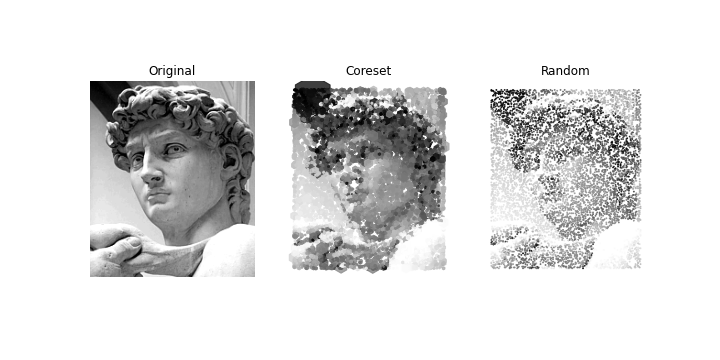© Crown Copyright GCHQ
Coreax is a library for coreset algorithms, written in JAX for fast execution and GPU support.
For
The
Some algorithms return the
Please see the documentation for some in-depth examples.
In the example below, we reduce the original 180x215
pixel image (38,700 pixels in total) to a coreset approximately 20% of this size.
(Left) original image.
(Centre) 8,000 coreset points chosen using Stein kernel herding, with point size a
function of weight.
(Right) 8,000 points chosen randomly.
Run examples/david_map_reduce_weighted.py to replicate.
Here we identify representative frames such that most of the
useful information in a video is preserved.
Run examples/pounce.py to replicate.
| Original | Coreset |
|---|---|
 |
 |
Install Coreax from PyPI by adding coreax to your project dependencies or running
pip install coreaxCoreax uses JAX. It installs the CPU version by default, but if you have a GPU or TPU,
see the
JAX installation instructions
for options available to take advantage of the power of your system. For example, if you
have an NVIDIA GPU on Linux, add jax[cuda12] to your project dependencies or run
pip install jax[cuda12]There are optional sets of additional dependencies:
coreax[test]is required to run the tests;coreax[example]contains all dependencies for the example scripts;coreax[benchmark]is required to run benchmarking;coreax[doc]is for compiling the Sphinx documentation;coreax[dev]includes all tools and packages a developer of Coreax might need.
Note that the test and dev dependencies include opencv-python-headless, which is
the headless version of OpenCV and is incompatible with other versions of OpenCV. If you
wish to use an alternative version, remove opencv-python-headless and select an
alternative from the
OpenCV documentation.
Should the installation of Coreax fail, you can see the versions used by the Coreax
development team in uv.lock. You can transfer these to your own project as follows.
First, install UV. Then,
clone the repo from GitHub. Next, run
uv export --format requirements-txtwhich will generate a requirements.txt. Install this in your own project before trying
to install Coreax itself,
pip install -r requirements.txt
pip install coreaxWe anticipate two release types: feature releases and security releases. Security releases will be issued as needed in accordance with the security policy. Feature releases will be issued as appropriate, dependent on the feature pipeline and development priorities.
Some features coming soon include:
- Coordinate bootstrapping for high-dimensional data.
- Other coreset-style algorithms, including recombination, as means to reducing a large dataset whilst maintaining properties of the underlying distribution.





